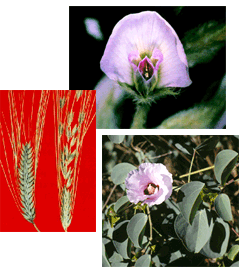Genetic Resources of Native Species

Barley and cotton are important agricultural crops in Australia, and their wild relatives are useful contributors to the development of modern elite cultivars. Australia is also home to nearly all the wild soybean relatives. Elite cultivars of these three cultivated species continue to be vulnerable to disease as fungal pathogens overcome currently deployed resistance alleles and new fungal pathotypes arise and spread. Their wild relatives are a rich source of new resistance alleles.
Use of wild crop relatives as a genetic resource begins with an understanding of their evolution, genetic composition, and the genetic control of disease resistance. This background is critical to designing coherent breeding strategies. Once fertile interspecific hybrids are realized, a variety of mapped molecular markers are used to monitor donor chromatin introgression as the genes controlling useful wild characters are incorporated into preliminary breeding lines. Concurrent investigations of the genetic structure of the crop pathogens complement the development of new breeding lines.
Representative germplasm collections of wild soybean (Glycine spp) and cotton (Gossypium spp) species indigenous to Australia, supplemented by 160 exotic accessions of barley (Hordeum vulgare) are the basis for these research programs. We built and maintain the Indigenous Relatives of Crops collection as part of the Australian Network of Plant Genetic Resources Centres. The collection contains some 2000 accessions of the Australian Glycine species and 400 of 17 Gossypium species.
Germplasm collections of wild crop relatives serve a multitude of purposes. They are gene repositories, preserving alleles of potential agronomic utility that have not been captured in the gene pool of elite cultivars. Because germplasm collections link extensive biogeographic data directly to readily available vouchered seed accessions, they are invaluable resources for evolutionary studies.
